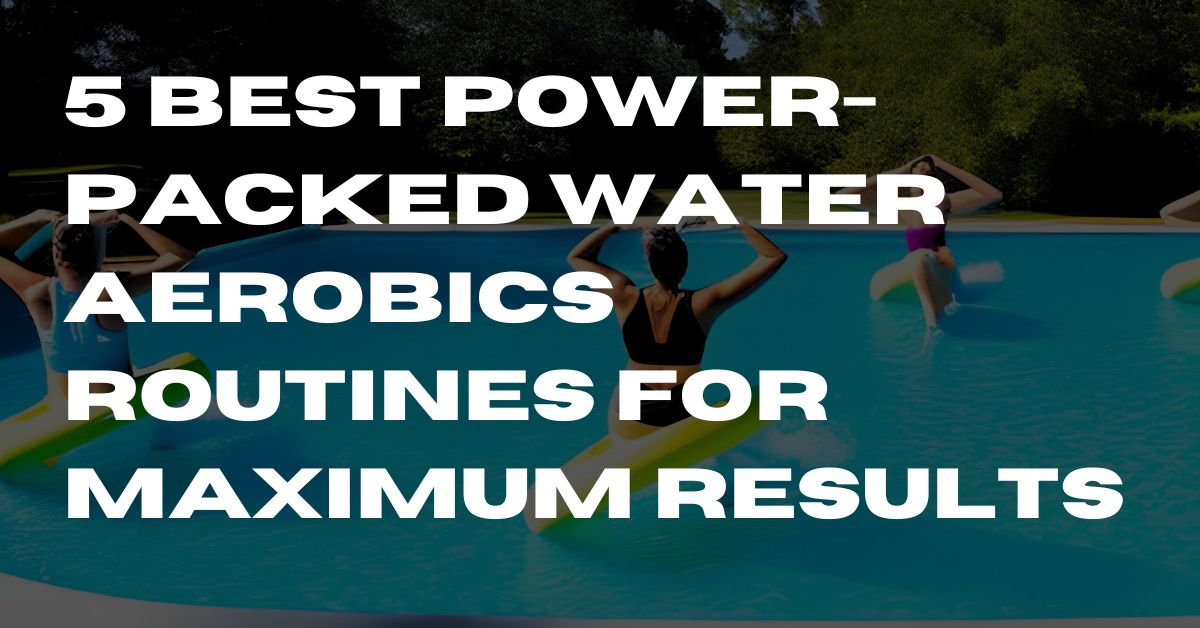Are you looking for a fun and effective way to shed those extra pounds? Look no further than water aerobics! Also known as aqua aerobics or water exercise, this engaging workout has gained popularity as a fantastic option for weight loss.
By combining cardiovascular exercise with the resistance of water, water aerobics provides a low-impact and highly efficient workout suitable for individuals of all fitness levels.
In this article, we will dive into the benefits of water aerobics for weight loss and explore how it can be an excellent addition to your fitness routine. Get ready to make a splash and achieve your weight loss goals!
Understanding Water Aerobics
Water aerobics, also known as aqua aerobics or water exercise, is a form of physical activity that takes place in a pool or aquatic environment. It involves performing a variety of aerobic exercises and movements specifically designed to be carried out in water. This low-impact workout combines cardiovascular exercise with the resistance of water, making it suitable for individuals of all fitness levels.
Water aerobics offers numerous benefits that contribute to overall fitness and weight loss. Firstly, the buoyancy of water reduces the impact on joints, making it an ideal exercise option for those with joint issues or injuries. Research has shown that water aerobics can help improve range of motion, flexibility, and muscle strength while minimizing stress on the joints.
In terms of weight loss, water aerobics can be highly effective. A study published in the Journal of Sports Science and Medicine found that water-based exercises, such as water aerobics, can lead to significant reductions in body fat and body mass index (BMI). The resistance provided by the water creates a challenging workout environment, requiring the muscles to work harder and leading to increased calorie expenditure.
Furthermore, water aerobics activates multiple muscle groups throughout the body. The resistance of the water provides continuous and evenly distributed resistance, engaging both the upper and lower body simultaneously. This full-body workout helps tone and strengthen muscles while burning calories. Research has shown that water aerobics can increase muscle strength and endurance, leading to improved body composition.
Water aerobics also offers the advantage of improved cardiovascular fitness. The water’s resistance requires the heart to work harder, leading to an increased heart rate and improved cardiovascular endurance. A study published in the American Journal of Cardiology found that water-based exercise programs can improve cardiovascular health and reduce the risk of cardiovascular disease.
How Water Aerobics Promotes Weight Loss
Water aerobics is a highly effective exercise option for promoting weight loss. Its unique properties and combination of cardiovascular exercise and resistance training in the water provide numerous benefits that contribute to shedding those extra pounds. Let’s delve into how water aerobics promotes weight loss, backed by research and evidence.
1. Calorie Burning:
Water aerobics is a highly effective calorie-burning exercise. The resistance provided by the water creates a natural form of resistance training, requiring your muscles to work harder to move against it. This increased effort translates into a higher caloric expenditure during your workout.
A study published in the Journal of Strength and Conditioning Research found that water-based exercises can result in a higher caloric burn compared to land-based exercises (*). The exact number of calories burned during water aerobics will depend on various factors such as the intensity and duration of the workout, as well as individual characteristics.
Nonetheless, water aerobics can be an efficient way to enhance calorie burn and contribute to weight loss.
2. Increased Muscle Activation:
Water aerobics engages multiple muscle groups simultaneously, providing a comprehensive full-body workout. The resistance of the water requires your arms, legs, core, and other muscle groups to work together, leading to improved muscle tone and strength.
Research has shown that water aerobics can increase muscle activation levels and provide similar benefits to land-based exercises (*). The resistance provided by the water challenges your muscles, promoting their development and increasing their metabolic demands.
As your muscles become stronger and more toned, they contribute to a higher metabolic rate, allowing you to burn more calories even at rest. This boost in metabolism can aid in weight loss efforts.
3. Low-Impact Exercise:
One of the significant advantages of water aerobics is its low-impact nature, which reduces stress on the joints and minimizes the risk of injuries. The buoyancy of water supports your body, making it an excellent choice for individuals with joint issues, arthritis, or those recovering from injuries.
A study published in the European Journal of Applied Physiology compared joint loading between water-based exercise and land-based exercise, and it found that water-based exercise resulted in less joint stress (*).
By providing a low-impact environment, water aerobics allows you to engage in intense workouts without putting excessive strain on your joints, enabling consistent exercise for weight loss. This makes it accessible and beneficial for individuals of all fitness levels.
4. Improved Cardiovascular Fitness:
Engaging in water aerobics can lead to improvements in cardiovascular fitness, which plays a crucial role in weight loss. The resistance provided by the water increases the workload on your heart and lungs, leading to an increased heart rate and improved cardiovascular endurance.
A study published in the Scandinavian Journal of Medicine & Science in Sports demonstrated that water-based aerobic training resulted in various cardiovascular health improvements, such as increased aerobic capacity and decreased resting heart rate (*).
By enhancing your cardiovascular fitness, water aerobics enables you to sustain longer and more intense workouts, maximizing calorie expenditure and aiding in weight loss.
Benefits of water aerobics
Water aerobics, also known as aqua aerobics or water exercise, offers a multitude of benefits that make it an excellent choice for individuals seeking a fun and effective workout. Whether you’re a beginner or a fitness enthusiast, water aerobics provides a low-impact yet challenging exercise option. In this article, we will explore the various benefits of water aerobics, supported by research and evidence, to help you understand why it is worth incorporating into your fitness routine.
1. Low-Impact Exercise:
Water aerobics stands out as a low-impact exercise that is gentle on the joints, making it particularly suitable for individuals with joint issues, arthritis, or those in the process of recovering from injuries. The buoyancy of water reduces the impact on your body, alleviating stress on the joints and minimizing the risk of injuries.
A study published in the National Library of Medicine compared the joint loading between water-based exercise and land-based exercise, highlighting the reduced joint stress associated with water-based activities (*).
This reduced impact allows you to engage in rigorous workouts without compromising joint health, making water aerobics an ideal exercise choice for those looking to stay active while minimizing joint strain.
2. Cardiovascular Conditioning:
Engaging in water aerobics provides a highly effective cardiovascular workout. The resistance provided by the water increases the workload on your heart and lungs, leading to improved cardiovascular fitness. A study published in the Journal of Medicine & Science in Sports demonstrated that water-based aerobic training led to enhancements in various cardiovascular health parameters, such as increased aerobic capacity and decreased resting heart rate.
By improving cardiovascular conditioning, water aerobics supports heart health, promotes efficient blood circulation, and aids in managing weight. Regular participation in water aerobics can help increase endurance, improve cardiovascular health, and contribute to overall fitness.
3. Muscle Strengthening:
Water aerobics engages multiple muscle groups simultaneously, providing a comprehensive full-body workout. The resistance offered by the water requires your muscles to work harder, leading to improved muscle tone and strength.
Research has shown that water aerobics can increase muscle activation levels and provide comparable benefits to land-based exercises (*). The resistance of the water provides a unique form of resistance training that target both major muscle groups and smaller stabilizing muscles.
Regular participation in water aerobics can lead to enhanced muscle definition and increased overall strength. The resistance offered by the water not only strengthens muscles but also helps to improve endurance and promote overall muscular balance.
4. Improved Flexibility and Range of Motion:
Water aerobics promotes improved flexibility and range of motion. The buoyancy of water reduces the effects of gravity, allowing for greater freedom of movement and enhanced flexibility.
Water aerobics incorporates various stretching and range-of-motion exercises, promoting joint flexibility and helping to maintain or improve your overall range of motion.
Additionally, water’s supportive properties enable individuals to perform movements that may be challenging on land, facilitating gentle stretching and increased flexibility.
Regular participation in water aerobics can contribute to improved flexibility, joint mobility, and overall physical agility.
5. Enhanced Rehabilitation and Recovery:
Water aerobics is widely recognized for its therapeutic benefits and is commonly recommended for rehabilitation and recovery purposes.
Its low-impact nature and gentle resistance make it an ideal exercise option for individuals in the process of rehabilitating from injuries or recovering from certain medical conditions.
The water’s buoyancy reduces the stress on injured or healing body parts, allowing individuals to perform rehabilitative exercises in a supportive and controlled environment. Water aerobics can aid in improving flexibility, strength, and range of motion while minimizing the risk of further injury.
Additionally, the hydrostatic pressure exerted by the water can help reduce swelling and promote circulation, further supporting the healing process.
Building Muscle With Water Aerobics
Water aerobics is not only a fun and refreshing way to exercise but also an effective method for building muscle. While many people associate muscle building with weightlifting and traditional gym workouts, water aerobics offers a unique and highly beneficial alternative. In this article, we will explore how water aerobics can help you build muscle and achieve your fitness goals.
One of the key factors that contribute to muscle building during water aerobics is the resistance provided by the water. The resistance of water is approximately 12 times greater than air, which means that your muscles must work harder to move against it.
This resistance creates a natural form of resistance training, engaging multiple muscle groups simultaneously. As you perform various water aerobics exercises, such as leg kicks, arm movements, and core exercises, the resistance offered by the water challenges your muscles, promoting muscle activation and growth.
Research supports the effectiveness of water aerobics for muscle building. A study published in the European Journal of Applied Physiology investigated the effects of water-based exercise on muscle strength and found significant improvements in muscle performance. Another study published in the Journal of Aging and Physical Activity demonstrated that water aerobics can increase muscle strength and endurance in older adults. These findings highlight the potential of water aerobics as a muscle-building exercise, not only for younger individuals but also for older adults.
Water aerobics offers a full-body workout that targets both major muscle groups and smaller stabilizing muscles. The resistance provided by the water engages muscles in your arms, legs, core, and back, leading to improved muscle tone, strength, and overall muscular balance. Unlike traditional weightlifting exercises that isolate specific muscle groups, water aerobics promotes functional movements that require multiple muscles to work together. This holistic approach to muscle activation can lead to improved overall fitness and functional strength.
Additionally, water aerobics offers the benefits of low-impact exercise. The buoyancy of water reduces the impact on your joints, making it a suitable choice for individuals with joint issues or those who want to minimize the risk of injury. By providing a low-impact environment, water aerobics allows you to engage in challenging workouts without putting excessive strain on your joints. This means that you can push your muscles to their limits without worrying about the potential negative effects on your joints, tendons, or ligaments.
Consistency is key when it comes to building muscle, and water aerobics can help you maintain a regular exercise routine. The enjoyable and refreshing nature of water aerobics makes it an exercise option that many people look forward to. The social aspect of group water aerobics classes or the serenity of performing solo water exercises can add motivation and make your workouts more enjoyable. By incorporating water aerobics into your fitness routine and staying consistent, you can effectively build and maintain muscle strength over time.
Water Aerobics vs. Traditional Aerobics
When it comes to aerobic exercise, there are various options available, including both water aerobics and traditional aerobics. Each type of exercise has its own unique characteristics and benefits.
One significant difference between water aerobics and traditional aerobics is the medium in which the exercise is performed. Water aerobics, as the name suggests, takes place in a pool or water environment. The buoyancy of the water reduces the impact on your joints, making it a low-impact exercise option. On the other hand, traditional aerobics typically involves movements performed on land, such as jogging, dancing, or step aerobics, which can have a higher impact on the joints.
Research has shown that water aerobics offers several advantages over traditional aerobics, particularly in terms of joint stress and injury prevention. A study published in the European Journal of Applied Physiology compared joint loading between water-based exercise and land-based exercise and found that water-based activities resulted in significantly less joint stress. This makes water aerobics an excellent choice for individuals with joint issues, arthritis, or those recovering from injuries.
Another key difference between water aerobics and traditional aerobics is the resistance provided. Water aerobics offers natural resistance due to the density of water, making it a form of resistance training. The resistance of water engages your muscles and requires them to work harder, leading to increased muscle activation and strength. Traditional aerobics, on the other hand, primarily focuses on cardiovascular endurance and may not provide the same level of resistance training.
Water aerobics can be an effective way to target and tone multiple muscle groups simultaneously. The resistance provided by the water challenges your muscles throughout the workout, leading to improved muscle tone and overall strength. A study published in the Journal of Strength and Conditioning Research compared the muscular activation between water-based exercises and land-based exercises and found similar benefits in terms of muscle activation. This suggests that water aerobics can be as effective as traditional aerobics in terms of muscle engagement and development.
In terms of calorie burning, both water aerobics and traditional aerobics can contribute to weight loss and improved cardiovascular fitness. The exact number of calories burned will vary based on factors such as intensity, duration, and individual characteristics. However, a study published in the Journal of Strength and Conditioning Research found that water-based exercises can result in a higher caloric expenditure compared to land-based exercises. This indicates that water aerobics can be an effective option for burning calories and achieving weight loss goals.
Best Water aerobics exercises
Here are some of the best exercises to perform under water aerobics:
Water Jogging:
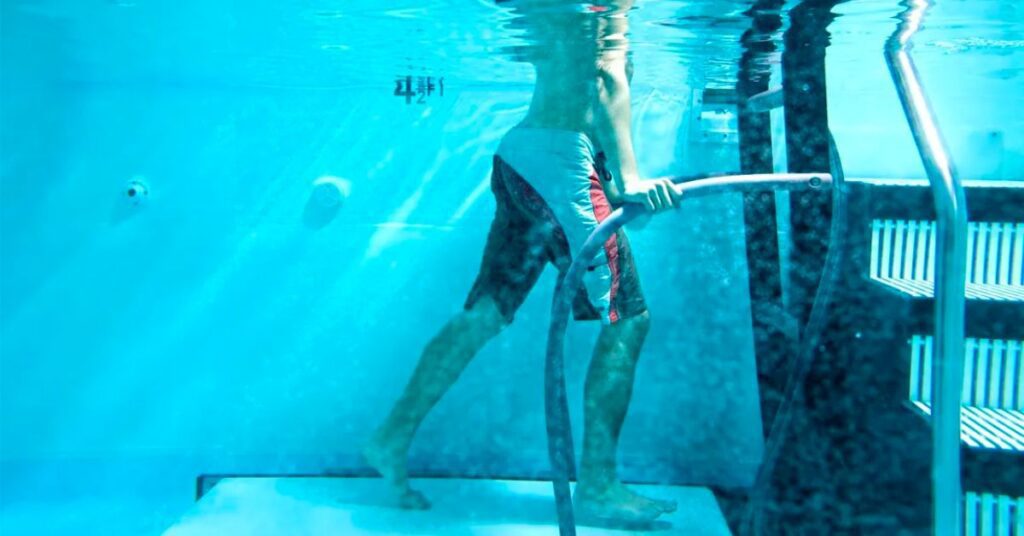
- Stand in water that is about waist-deep.
- Begin jogging in place, lifting your knees up towards your chest.
- Maintain an upright posture and engage your core muscles.
- Move your arms in a jogging motion as well, alternating them forward and backward.
- Continue jogging for 10-15 minutes, gradually increasing the intensity and speed to challenge your cardiovascular system and burn calories.
Water Aerobic Dance:
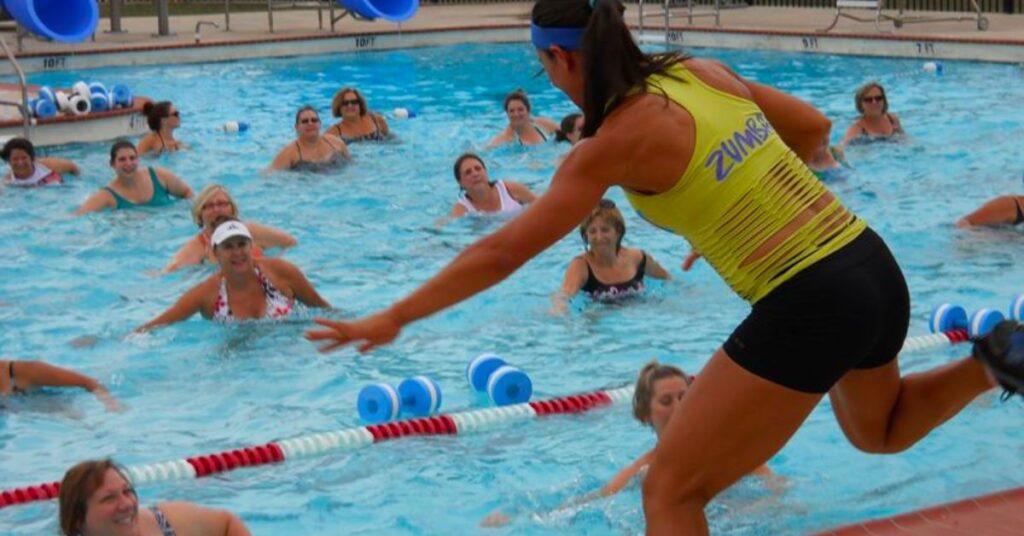
- Stand in water that is chest-deep.
- Start by performing simple dance moves, such as stepping side to side, marching in place, or kicking your legs forward.
- Move your arms in coordination with the leg movements, adding flair and rhythm to your routine.
- Incorporate variations like grapevine steps, knee lifts, or cross steps to keep the workout engaging and fun.
- Dance for 20-30 minutes, maintaining a steady pace and focusing on your movements and form.
Water Jumping Jacks:
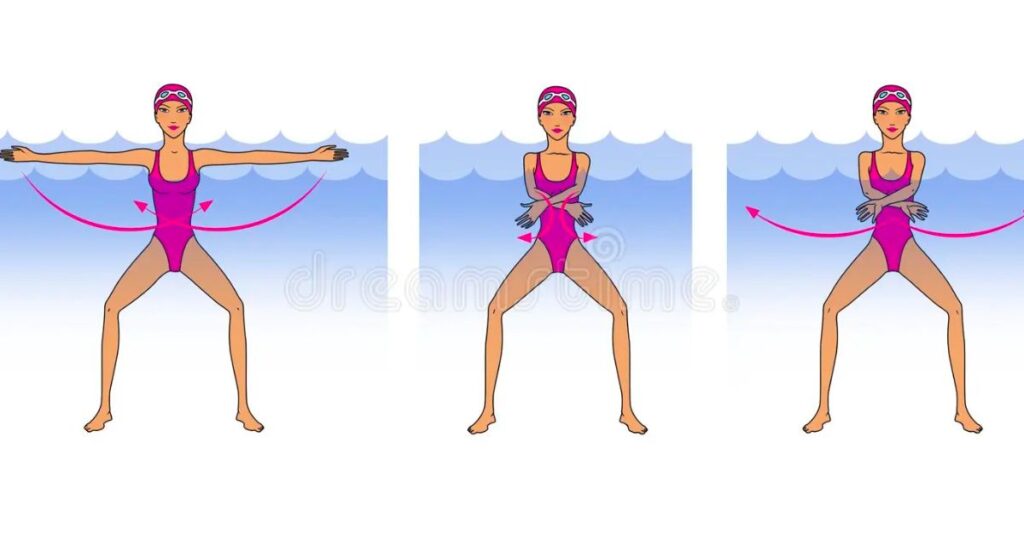
- Stand in water that is chest-deep, ensuring you have enough space around you.
- Start with your feet together and arms resting by your sides.
- Jump up, spreading your legs wider than hip-width apart and simultaneously raising your arms out to the sides and above your head.
- Land softly with your feet apart and arms extended.
- Jump back to the starting position, bringing your feet together and arms back to the sides.
- Repeat the movement for a set duration, such as 1 minute, or perform a specific number of repetitions.
Water Bicycle Crunches:
- Stand in water that is waist-deep and place your hands on the pool edge or hold onto a flotation device for support.
- Lift your knees towards your chest, mimicking a cycling motion.
- As you lift your right knee, twist your torso to bring your left elbow towards your right knee.
- Alternate sides, bringing your left knee towards your chest while twisting to bring your right elbow towards your left knee.
- Continue cycling and twisting for a set duration or number of repetitions, focusing on engaging your core muscles with each twist.
Water Resistance Exercises with Water Weights:
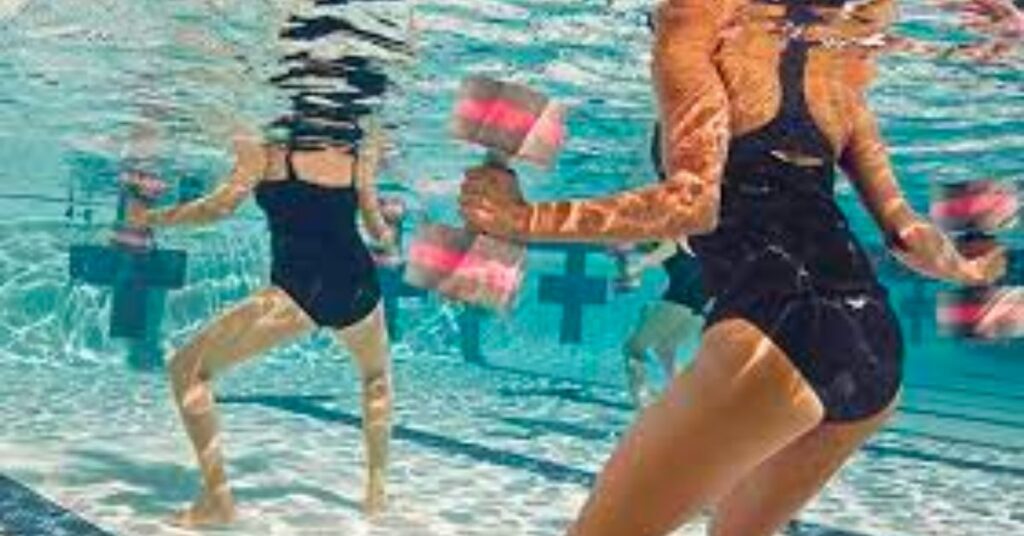
- Stand in water that is waist-deep and hold water weights or dumbbells in your hands.
- Perform various resistance exercises such as bicep curls, shoulder presses, tricep extensions, and lateral raises.
- Ensure that your movements are controlled and deliberate, focusing on proper form and technique.
- Complete 2-3 sets of 10-15 repetitions for each exercise, resting briefly between sets.
- The water resistance combined with the added weights will challenge your muscles and help increase muscle strength and tone.
Tips for a Successful Water Aerobics Session
- Wear Appropriate Swimwear: Choose swimwear that allows freedom of movement and provides adequate support. Opt for a swimsuit that is comfortable and allows you to move easily in the water. For added support, consider wearing a supportive sports bra or a rash guard.
- Stay Hydrated: Even though you are in the water, it’s important to stay hydrated during your water aerobics session. Bring a water bottle and take regular sips of water throughout the workout to prevent dehydration. Remember, even though you may not feel as sweaty as during land-based exercises, your body still needs hydration.
- Use Aquatic Equipment: Utilize aquatic equipment such as foam noodles, water dumbbells, or kickboards to add variety and resistance to your workouts. These tools can help increase the intensity of your exercises and target specific muscle groups. Consult with your instructor to learn proper techniques for using the equipment.
- Focus on Form and Technique: Pay attention to your form and technique during water aerobics exercises. Proper form helps maximize the effectiveness of the workout and reduces the risk of injury. Listen to your instructor’s cues and make adjustments as needed to maintain proper alignment and engage the correct muscles.
- Vary Your Exercises: Keep your water aerobics sessions interesting by incorporating a variety of exercises. Mix up cardiovascular exercises like jogging or jumping jacks with strength-training exercises like arm curls or leg presses. Adding variety not only prevents boredom but also challenges different muscle groups and promotes overall fitness.
- Adjust Intensity to Your Fitness Level: Modify the intensity of your water aerobics workout to match your fitness level. If you’re a beginner, start with low-impact exercises and gradually increase the intensity as you become more comfortable and fit. Likewise, if you’re more advanced, challenge yourself with higher-intensity exercises or by increasing the duration of your workout.
- Listen to Your Body: Pay attention to how your body feels during the water aerobics session. If you experience any pain or discomfort, modify or stop the exercise. It’s essential to listen to your body’s signals and not push yourself beyond your limits. Consult with your instructor if you have any concerns or questions.
- Practice Breathing Techniques: Focus on your breathing during water aerobics exercises. Practice rhythmic breathing by inhaling deeply through your nose and exhaling through your mouth. Proper breathing helps oxygenate your muscles and improves endurance during the workout.
- Warm-Up and Cool Down: Begin each water aerobics session with a gentle warm-up to prepare your muscles and joints for the exercises ahead. Incorporate stretches and gentle movements to gradually increase your heart rate and flexibility. Similarly, end your session with a cool-down period that includes stretching to help reduce muscle soreness and promote recovery.
- Enjoy the Experience: Lastly, remember to have fun and enjoy the experience of water aerobics. The water provides a refreshing and enjoyable environment for exercise. Embrace the unique properties of water, the soothing sensation, and the freedom of movement it offers. Enjoy the camaraderie of the group, the music, and the energy of the session.
Conclusion
In conclusion, water aerobics offers numerous benefits for individuals looking to engage in a fun and effective fitness routine while promoting weight loss. Through its combination of cardiovascular exercise, resistance training, and low-impact nature, water aerobics provides a well-rounded workout suitable for people of all fitness levels.
The research and evidence support the effectiveness of water aerobics in burning calories, increasing muscle activation, improving cardiovascular fitness, and enhancing flexibility. Additionally, the low-impact nature of water aerobics makes it a safe and accessible exercise option for individuals with joint issues or those recovering from injuries.
By incorporating water aerobics into your fitness routine, you can enjoy a refreshing and engaging workout while working towards your weight loss goals. So, dive in, embrace the water, and experience the many benefits that water aerobics has to offer for your overall health and well-being.
FAQs
1. Can water aerobics help me lose belly fat?
Yes, water aerobics can contribute to overall weight loss, including reducing belly fat. Consistent participation in water aerobics sessions, combined with a balanced diet, can help you shed excess fat from your abdomen.
2. How often should I do water aerobics to see results?
To see noticeable results, aim to do water aerobics at least two to three times a week. Consistency is key to achieving and maintaining weight loss and fitness goals.
3. Can I do water aerobics if I can’t swim?
Absolutely! Water aerobics exercises are primarily performed in shallow water, and swimming skills are not required. You can enjoy the benefits of water aerobics regardless of your swimming abilities.
4. Is water aerobics suitable for individuals with joint pain or injuries?
Yes, water aerobics is often recommended for individuals with joint pain or injuries. The buoyancy of water reduces impact and provides a supportive environment for exercising without aggravating existing conditions.
5. How long should a typical water aerobics session last?
A typical water aerobics session can last anywhere from 30 to 60 minutes. However, the duration may vary based on your fitness level, instructor guidelines, and personal preferences.

